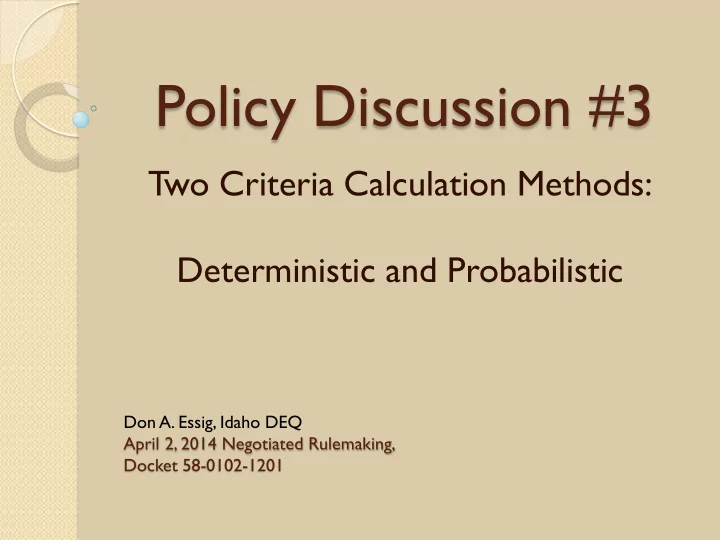

Policy Discussion #3 T wo Criteria Calculation Methods: Deterministic and Probabilistic Don A. Essig, Idaho DEQ April 2, 2014 Negotiated Rulemaking, Docket 58-0102-1201
Outline Human Health Criteria Equations - Revisited Needed Input Data Sources of Data / Selection of Input Value(s) Flowchart of Probabilistic Calculation Comparison of the Two Approaches Recommendations
Criteria Equations Non-cancer effects 𝐶𝐵 𝐵𝐵𝐵𝐵 = 𝑆𝑆𝑆 × 𝑆𝑆𝐵 × 4 𝑆𝐸 + ∑ 𝐺𝐸 𝑗 × 𝐶𝐵𝐺 𝑗 𝑗=2 Cancer effects: linear low-dose extrapolation 𝐶𝐵 𝐵𝐵𝐵𝐵 = 𝑆𝑆𝑆 × 4 𝑆𝐸 + ∑ 𝐺𝐸 𝑗 × 𝐶𝐵𝐺 𝑗 𝑗=2
Inputs … Describing the target population BW = Body Weight (Kg) DI = Drinking-water Intake (L/day) FI = Fish Intake, aka consumption rate (g/day) Describing each chemical BAF = Bioaccumulation Factor (L/Kg) RfD / RSD = Reference Dose, non-carcinogens or Risk Specific Dose, for carcinogens (mg/Kg-day) RSC = Relative Source Contribution (ratio)
Sources of data
Deterministic Approach Non-cancer effects 𝐶𝐵 𝐵𝐵𝐵𝐵 = 𝑆𝑆𝑆 × 𝑆𝑆𝐵 × 𝑆𝐸 + 𝐺𝐸 × 𝐶𝐵𝐺 Cancer effects: linear low-dose extrapolation 𝐶𝐵 𝐵𝐵𝐵𝐵 = 𝑆𝑆𝑆 × 𝑆𝐸 + 𝐺𝐸 × 𝐶𝐵𝐺 Select values for each input and calculate, once
DERIVING WATER QUALITY CRITERIA USING A PROBABILISTIC METHODOLOGY: CARCINOGENS 𝑺𝑺𝑺𝑺 = 𝑻𝑻𝑻 × 𝑬𝑬 + 𝑮𝑬 × 𝑪𝑪𝑮 𝑪𝑻 × 𝑺𝑻𝑬 BAF RSD SWC BW DI FCR Calculate risk probabilistically with distributions (DI, FI, BW) and point estimates (BAF*, RSD) for a specific water concentration (SWC)
90% < 1.00E-05 This is a policy choice Iterative selection of higher or lower Risk = Target? SWC to achieve risk target Yes Conduct sensitivity Use SWC as water quality analysis with high fish criterion consuming subpopulation
The key difference, going in For a deterministic calculation we need to choose a value out of each distribution to represent the population For a probabilistic calculation we use whole distributions to represent the population
The key difference, coming out With deterministic calculation the result is a criterion value, with uncertain risk With probabilistic calculation result is a distribution of risk, for a concentration
Deterministic Calculation Pros Cons Well established Uncertainty in risk / level of protection Easy to calculate provided Criteria calculation less Compound costly conservatism Does not use all the information and knowledge we have
Probabilistic Calculation Pros Cons Uses all available More complex information Process is not easily Addresses variability explained and uncertainty directly Does not eliminate Clearer communication difficult policy decisions of risk to public and for > Target population policy makers > Sources of fish consumed > Protective risk level
DEQ Summary & Recommendations PRA is more “state of the art” Could only do partial PRA: ◦ Fish consumption rate ◦ Body weight ◦ Drinking water intake PRA is a step forward, but we would likely need outside help Unclear what difference it would make to criteria
We would like your comments on these matters… Comment deadline is April 23 rd , 2014
90% < 1.00E-05
Recommend
More recommend